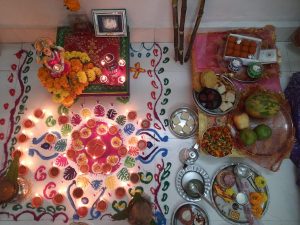Roots of Rangoli:
Originating in India, the word “rangoli” is derived from the Sanskrit words ‘rang’ (colour) and ‘avalli’ (row of colors). The practice dates back centuries, finding mentions in ancient texts and scriptures. Initially, it was a simple ritual of creating patterns using rice flour, symbolizing hospitality and a festive atmosphere.
Materials and Techniques:
While rice flour remains a traditional choice, modern rangoli artists experiment with various materials like coloured powders, flower petals, and even eco-friendly materials. The techniques range from freehand drawing to using stencils, ensuring a wide spectrum of creativity.
Symbolism in Symmetry:
Rangoli designs often incorporate symmetrical patterns, reflecting balance and harmony. The symmetry also signifies the unity of the family and the community. Various motifs, such as flowers, birds, and religious symbols, contribute to the rich symbolism embedded in each creation.
Festivals and Occasions:
Rangoli is an integral part of festivals like Diwali, Pongal, and Navaratri, where homes are adorned to welcome guests and bring good luck. The vibrant colors used are believed to invoke positive energy and ward off evil spirits.
Global Influence:
Beyond India, rangoli has gained recognition globally. Its captivating beauty and cultural significance have sparked interest in communities around the world. Workshops and events dedicated to rangoli are becoming increasingly popular, fostering cross-cultural appreciation.
Rangoli is not merely a decorative art; it’s a celebration of culture, tradition, and creativity. Its evolution over the years showcases the adaptability of an ancient practice in the face of modernity. As rangoli continues to weave its colourful threads through festivities and daily life, it remains a testament to the enduring spirit of artistic expression.
Here is one video for you to enjoy!





















